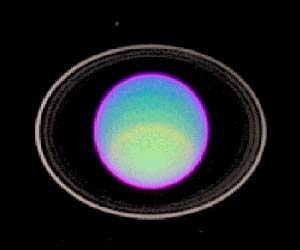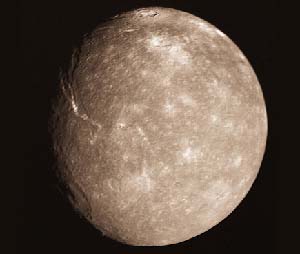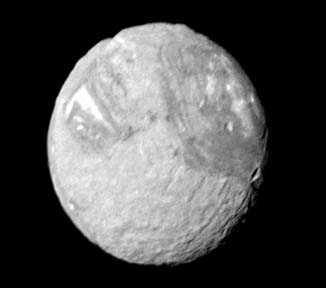|
Planet Uranus
|
Uranus Rings
 Infrared image of Uranus, the rings have been brightened to make them visible
Infrared image of Uranus, the rings have been brightened to make them visible
Titania
 The largest moon of Uranus, Titania
The largest moon of Uranus, Titania
Planet Uranus Facts
- Uranus is the seventh planet from the sun and the third largest in the solar system.
- Its diameter is 31,763 miles (51,118 km) which is four times larger than Earth.
- It is a giant ball of gas and liquid surrounded by 11 very faint rings.
- Uranus is tilted on its side possibly after a collision with another planet.
- Its rather bland appearance has changed slightly since the Voyager 2 visit in 1985 as new cloud formations have appeared across the planet.
- Wind speeds in Uranus can reach 560 mph (900 km/h).
- Uranus is the farthest planet that can be seen without a telescope.
- Light from Uranus takes 2 hours 40 minutes to reach Earth.
- The interior of Uranus is made up of an extremely hot liquid ocean comprising of water, ammonia and other volatile elements.
- Uranus was discovered in 1781 by the British astronomer William Herschel.
Orbit, Atmosphere & Temperature
 Voyager 2 image of Uranus
Voyager 2 image of Uranus
Orbit
Uranus orbits the sun every 84 years at an average distance of 1.8 billion miles (2.9 billion km) and spins on its own axis every 17 hours compared to 24 hours on Earth.
Atmosphere
The atmosphere of Uranus is made up of around 83% hydrogen, 15% helium, 2% methane and small amounts of ethane and other gases. The presence of methane
gives Uranus its turqoise colour.
Temperature
Uranus has the coldest atmospheric temperature of any planet in the solar system, around -224C (-371F).
Temperatures in its interior are very high, core temperatures could reach 7000C (12,600 F).
| Moons |
| Discovery and Origin of Name |
Uranus has 27 known satellites consisting of 5 large icy moons and a clutter of smaller moons. The largest of these is Titania (picture above) with a diameter of just under 1,000 miles (1600 km),
around half the size of our own moon. Unusually instead of being named after Greek or Roman deities the satellites are named after characters from the plays of Shakespeare and the works of Alexander Pope.
William Herschel discovered Uranus in 1781 although he named the planet Georgium Sidus (George's Star) after the then King of England, George III.
However the name was deeply unpopular outside of the United Kingdom so the German astronomer Johann Elert Bode named the planet Uranus after the
Greek god of the sky. By the mid 19th century Georgium Sidus was no longer used and Uranus became the accepted name for the planet.
| Future and Past Missions to Uranus |
Voyager 2
 Launch: August 1977
Launch: August 1977Arrival: November 1985
Agency: NASA
Voyager 2 is the only spacecraft to have visited Uranus. It made a sucessful flyby of the planet taking almost 8,000 images and discovering 10 new moons.
The images it took of Uranus showed a greenish blue rather featurless ball. There are no future missions planned.
|
Planet Uranus - Vital Statistics
Comparison with Earth
|
Diameter: 31,763 miles (51,118 km)
Average Distance from Sun: 1.8 billion miles (2.9 billion km)
Orbital Period: 84 years
Rotation Period: 17.24 hours
Maximium Temperatures: 7000C (12,600F) (Core)
Minumum Temperatures: -224C (-371F) (Cloud Tops)
Gravity: 8.43 m/s2 (86% Earth's Gravity)
Density: 1.3 g/cm3 (23.6% Earth's Density)
Mass: 8.6849 x 1025 kg (14 x Earth's Mass)
Volume: 6.8330 x 1013 km3 (63 x Earth's Volume)
Atmosphere: 83% Hydrogen, 15% Helium, 2% Methane.
Average Distance from Sun: 1.8 billion miles (2.9 billion km)
Orbital Period: 84 years
Rotation Period: 17.24 hours
Maximium Temperatures: 7000C (12,600F) (Core)
Minumum Temperatures: -224C (-371F) (Cloud Tops)
Gravity: 8.43 m/s2 (86% Earth's Gravity)
Density: 1.3 g/cm3 (23.6% Earth's Density)
Mass: 8.6849 x 1025 kg (14 x Earth's Mass)
Volume: 6.8330 x 1013 km3 (63 x Earth's Volume)
Atmosphere: 83% Hydrogen, 15% Helium, 2% Methane.
Diameter: 7,926 miles (12,756 km)
Average Distance from Sun: 93 million miles (150 million km)
Orbital Period: 365.24 days
Rotation Period: 23.934 hours
Maximium Surface Temperatures: 58C (136F)
Minumum Surface Temperatures: -88C (-126F)
Gravity: 9.766 m/s2
Density: 5.515 g/cm3
Mass: 5.9737 x 1024 kg
Volume: 1.0832 x 1012 km3
Atmosphere: 78.08% nitrogen, 20.95% oxygen, 0.93% argon, 0.038% carbon dioxide.
Average Distance from Sun: 93 million miles (150 million km)
Orbital Period: 365.24 days
Rotation Period: 23.934 hours
Maximium Surface Temperatures: 58C (136F)
Minumum Surface Temperatures: -88C (-126F)
Gravity: 9.766 m/s2
Density: 5.515 g/cm3
Mass: 5.9737 x 1024 kg
Volume: 1.0832 x 1012 km3
Atmosphere: 78.08% nitrogen, 20.95% oxygen, 0.93% argon, 0.038% carbon dioxide.
| Moons of Uranus - Images |
Uranus moon Miranda


Uranus moon Oberon


Uranus moon Umbriel


| Sponsored Links |
